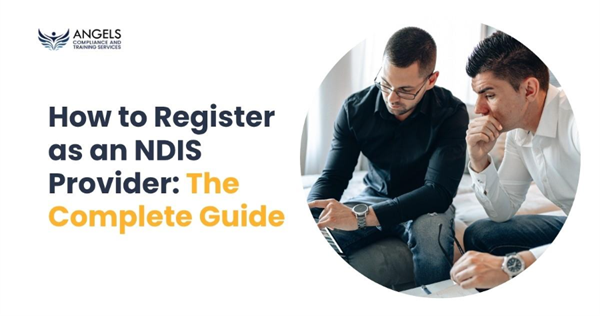Why Register as an NDIS Provider?
Understanding the Value Behind the Registration
The National Disability Insurance Scheme (NDIS) was built on the promise of empowering Australians with disabilities by giving them more choice and control. But that promise also comes with responsibility. That’s where NDIS provider registration comes in.
Getting registered with the NDIS isn’t just a checkbox. It means you’re committed to quality, accountability, and professionalism. It allows you to:
Offer services to participants with NDIA-managed funds.
Build trust with clients by working as a registered NDIS Provider.
Access greater business opportunities and showcase compliance with industry standards.
Whether you’re a therapist, support worker, plan manager, or run a disability-focused company—being registered gives you credibility and access to a broader market.
Table of Contents
Who Should Register and When?
Mandatory vs. Voluntary Registration
Here’s the thing: not every provider has to register. However, registration is mandatory if you intend to:
Work with NDIA-managed participants.
Deliver supports involving restrictive practices.
Offer Specialist Disability Accommodation (SDA).
Provide behavior support interventions.
If you’re only working with plan-managed or self-managed participants, registration is optional. That said, many choose to register as an NDIS Provider to demonstrate professionalism and expand their reach. Learn more about Candy Alternatives that can support healthier choices for participants.
The NDIS Provider Registration Process Explained
Step-by-Step Breakdown
The registration process can feel a bit intimidating at first glance, but it becomes a lot more manageable when you understand the steps.
Step 1: Access the NDIS Commission Portal
Head over to the NDIS Commission and create a provider account. This portal is your base of operations for submitting applications and uploading documents.
Step 2: Complete the Online Application
You’ll need to provide:
- Business details (ABN, structure, contacts)
- Services you plan to offer
- Key personnel information
- Policies and procedures aligned with the NDIS Practice Standards
Step 3: Undergo a Third-Party Audit
Once your application is submitted, you’ll need to hire an approved quality auditor. The type of audit—verification or certification—depends on the complexity of services you offer.
Step 4: Submit Audit Results
After the audit, your provider profile and audit outcome will be reviewed by the NDIS Commission.
Step 5: Await Approval
If all goes well, you’ll receive your registration certificate outlining your approved registration groups and validity period (typically 3 years).
Documentation You’ll Need to Provide
Be Prepared to Show Your Work
The NDIS takes documentation seriously, and for good reason. You’ll need to have the following ready to go:
- Business registration and insurance documents
- Evidence of worker screening and qualifications
- Incident management and complaint handling policies
- Risk management plans
- Participant feedback mechanisms
Make sure these documents are tailored to the services you offer. Generic templates might save time upfront but could cause delays or rejections later on.
Importance of NDIS Training Compliance
Your Staff Need to Know the Rules
It’s not enough to have good intentions—your team needs the skills and knowledge to back it up. That’s why NDIS training compliance is a cornerstone of successful service delivery.
All staff should be trained on:
- The NDIS Code of Conduct
- NDIS Practice Standards
- Incident reporting procedures
- Participant rights and confidentiality
Proper training ensures your team not only understands their responsibilities but also knows how to deliver care that meets regulatory expectations. And yes, during audits, your training records will be reviewed—so make sure they’re up to date and accessible.
Post-Registration Responsibilities
It Doesn’t Stop at the Certificate
Getting registered is just the beginning. Once you’re in, you’re required to:
- Maintain regular internal audits
- Keep your documentation current
- Submit annual provider declarations
- Stay up to date with NDIS policy changes
- Respond promptly to incidents and complaints
It’s essential to embed a culture of compliance and continuous improvement into your operations. That way, you’ll be prepared when your three-year audit rolls around—or if the Commission comes knocking sooner.
Common Pitfalls and How to Avoid Them
Learn From Other Providers’ Mistakes
Even experienced providers can trip up. Here are a few things to watch out for:
- Incomplete documentation: Missing one policy can stall your application.
- Untrained staff: Even casual or part-time workers need to complete mandatory training.
- Using outdated procedures: The NDIS standards evolve—your policies should too.
- Neglecting ongoing compliance: Don’t wait for audit time to start checking your systems.
Pro tip: Consider doing a mock internal audit every 6 months. It keeps your team sharp and your documentation tidy.
Tools and Support Available to You
You Don’t Have to Go It Alone
Need help getting through the maze? Here are some resources you can lean on:
NDIS Provider Toolkit (on the NDIS website)
Compliance management software like Brevity or iAuditor
Industry consultants specializing in NDIS registration
Online training platforms offering NDIS-compliant modules
Provider peer networks where you can share tips and experiences
Taking advantage of these tools can save you time, money, and stress. For a complete guide on working effectively within the system, check out Navigating the NDIS.
Real-World Success: Stories from the Field
The Payoff of Doing It Right
One Melbourne-based provider shared that after registering, their client base tripled in under a year—simply because they were now accessible to NDIA-managed participants.
Another rural provider noted that investing early in proper documentation and staff training helped them pass their audit on the first try, with zero recommendations for improvement—a rare feat!
These stories are a testament to what’s possible when you take the registration process seriously and aim for excellence from day one.
In a Nutshell: What It Takes to Become a Trusted NDIS Provider
Becoming a registered NDIS provider is no small feat—but it’s one that comes with serious benefits for your business and the people you support. From following the right steps during NDIS provider registration to embedding a strong culture of NDIS training compliance, success lies in preparation, consistency, and a willingness to grow.
Stay organized, stay informed, and stay committed to quality—and you’ll not only meet the standard, you’ll exceed it.


